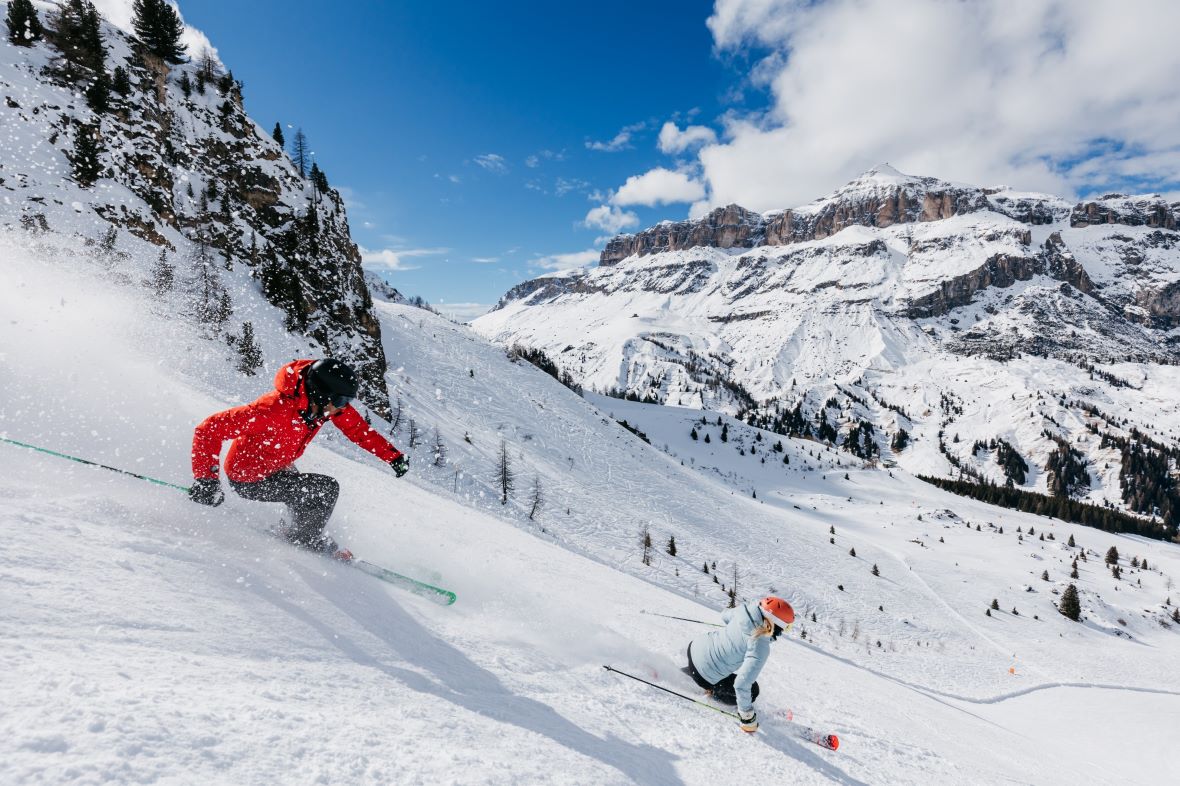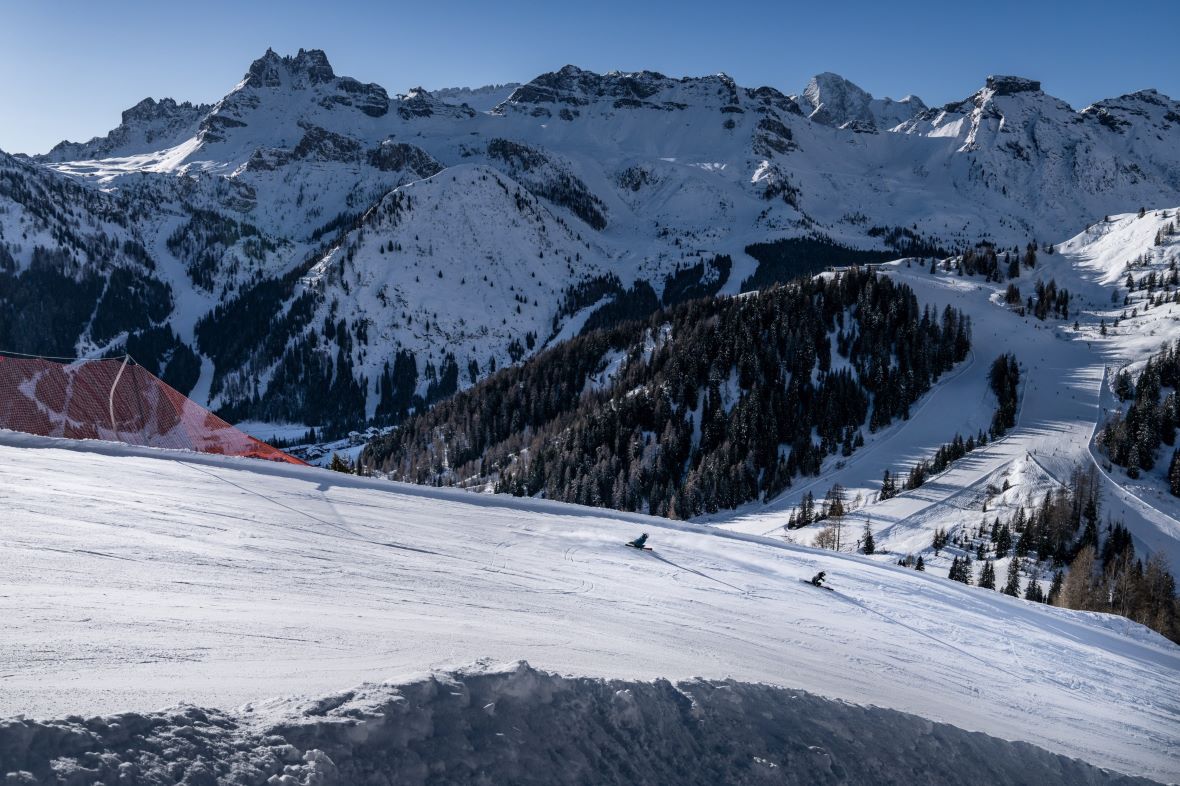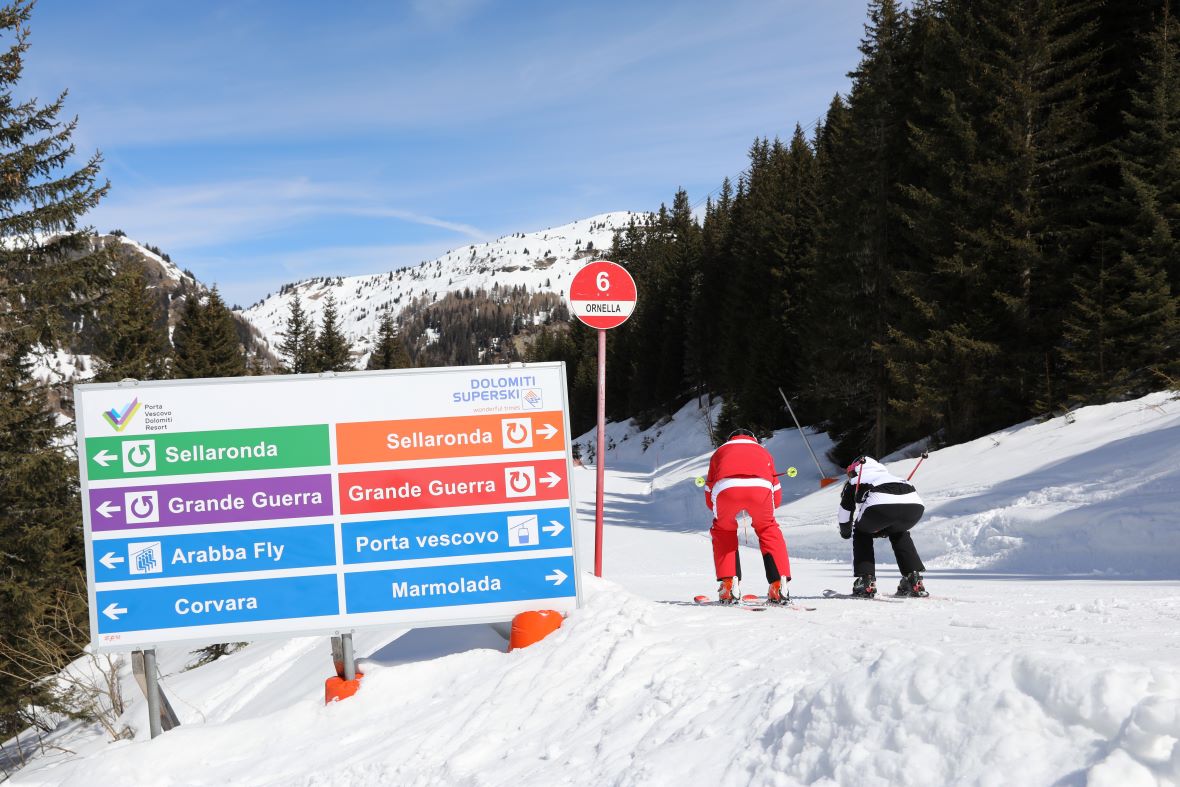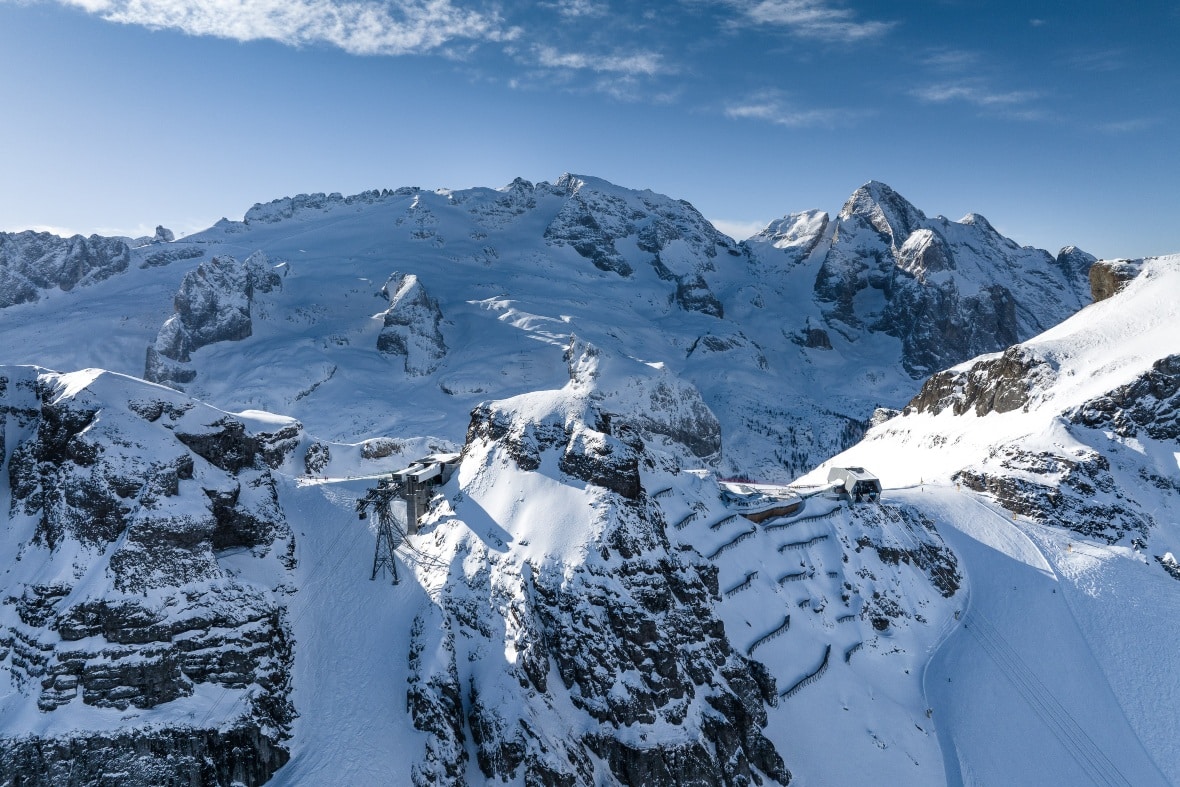Skiing in Arabba-Marmolada
Arabba’s local ski area includes the steep slopes of Porta Vescovo and the snowsure Marmolada glacier. Arabba is also on the Sellaronda circuit, and lift-linked to Alta Badia, Val di Fassa and Val Gardena. The Grande Guerra circuit connects Arabba by bus to Ski Civetta and Cortina d’Ampezzo

Arabba’s pistes are steeper than those in other Sellaronda resorts © Arabba Fodom Turismo
Ski Area Overview
Porta Vescovo
Porta Vescovo is the steep north facing mountainside directly above Arabba that is famous for its challenging red and black runs. The cable car’s top station elevation of 2,478m is usually cited as the top of Porto Vescovo but the Forcella Europa gondola actually goes higher than this, reaching over 2,500m. From here you can ski all the way down to Arabba at 1,602m, a total vertical drop of approximately 900m. The bottom half is mostly covered by woods, so in poor visibility you can stick to the lower treelined slopes.
There are about 10 pistes on Porta Vescovo. At the centre is the excellent, top-to-bottom, red piste Ornella (#6). Sprouting from this, are three steeper black runs that stronger skiers will enjoy: #5 Sourasass, #3 Fodoma and #13 Ornella Variente.
There are more red runs on the right-hand flank of Porta Vescovo, accessed either from Ornella or from the Portados gondola followed by the Carpazza chair. Salere (1) and Raccordo Salere (14) are on the Sellaronda Orange route and take skiers to Pont de Vauz, the gateway to the Val di Fassa ski area.
There is no easy blue route down to Arabba from Porta Vescovo, so it’s no place for beginners. Blue piste #4 Pordoi, which is part of the Sellaronda green anti-clockwise circuit, skirts the bottom of the sector, enabling skiers coming over from Val di Fassa to skip it out entirely.
Near the gondola and cable car base station is the 2-way Arabba Fly chairlift which links Porta Vescovo to Burz on the other side of Arabba.
Marmolada Glacier
From Arabba, you can ski over to Marmolada from Porta Vescovo via Passo Padon followed by red (#50) and blue slope (#52). These are not steep and in right conditions are beautiful runs but face south so watch out for ice or slush. At their bottom lies the Marmolada base station at Malga Ciapela (1,446m).
The only way up to the Punta Rocca top station on Marmolada at 3,269m is via the three stage cable car. There is one long red piste down Marmolada (#60 Bellunese) with a black variant (#65 Sall del Mul) at mid mountain. It’s a long and very scenic descent with a vertical drop of 1823m if you ski all the way back to Malga Ciapela , but you can terminate the run at the Padon chair lift to return to Porta Vescovo and Arabba.
Burz, Bec de Roces, and Passo Campolongo

Roc de Beces with Burz and Porta Vescovo in background © Matteo Agreiter Photography – Arabba Fodom Turismo
Burz is the small mountain (1943m) on the other side of Arabba to Porta Vescovo. It’s linked to Porta Vescovo by the 2-way Arabba Fly lift, so skiers don’t need to walk across the village to get from one side to the other. The Burz pistes end near the centre of Arabba and this is also where Arabba’s nursery slope is.
From the top of Burz, you either ski straight back down the same south-east facing mountainside that you have just ascended in the lift on a tricky south-facing black run (#21 Burz), or you ski down the north-face, which usually has much better snow, where there is one red run and two blues which lead onto the main Sellaronda circuits.
The Orange clockwise returns you to Arabba, and the green anti-clockwise circuit continues onto Alta Badia via Bec de Roces and Passo Campolongo.
Pont de Vauz and Passo Pordoi
From Pont de Vauz a gondola gets you over to Passo Pordoi and into Val di Fassa. Blue runs return you to Arabba.
The Sass Pordoi cable car is in Val di Fassa but covered by the Arabba lift pass. It ascends to 2950m. There are no pistes down so it is used only by people wanting to see the views from the summit, and freeride skiers who use it as the starting point for off-piste runs such as the Val Mezdí.
Arabba and the Sellaronda
Arabba is on the Sellaronda circuit, and skiers staying in Arabba can use the Sellaronda (sometimes spelt “Sella Ronda“) to ski over to Alta Badia, Val Gardena, and Val di Fassa. This gives them access to one of the world’s largest lift-linked ski areas (about 500kms of ski slopes, divided into about 400 separate runs) provided they have a Dolomiti Superski lift pass.
You can also spend a day simply going around the Sellaronda in either a clockwise (the ‘Orange route’ with orange signposts), or anti-clockwise (the ‘Green route’ with green signposts) direction.
Both circuits are about 40km long (of which approximately 25km is piste) and are well within the capability of most intermediate-level skiers. There are a few mandatory red runs however, so neither circuit is suitable for beginners or very nervous skiers. The Green Anti-Clockwise route is slightly easier than the Orange one but it does have more lifts.
Most skiers complete the Sellaronda in under three and a half hours if they don’t stop. But with breaks, detours, refreshments and lift queues, it takes an entire day. Therefore you are strongly advised to start the circuit before 10am.

Arabba is on the Sellaronda and Grande Guerra circuits ©Arabba_Fodom_Turismo
Arabba and the Grande Guerra circuit.
The First World War or “Grande Guerra” circuit links Arabba with the Ski Civetta ski resorts of Alleghe and Pescul, and Cortina d’Ampezzo and Alta Badia.
Like the Sellaronda, the Grande Guerra can be skied in either a clockwise direction (purple signs) or anti-clockwise (red signs). It takes a full day to complete.
From Arabba the red route is best because it includes the long beautiful Lagazuoi red run connecting Passo Falzarego in Cortina d’Ampezzo with Armentarola in Alta Badia.
You ski from Arabba to Malga Ciapela (Arabba-Marmolada ski area); then take a bus from Malga Ciapela to Alleghe; then ski from Alleghe to Pescul (Ski Civetta ski area); then take a bus from Pescul to Fedare; then ski from Fedare to Lagazuoi (Cortina d’Ampezzo ski area); then ski from Lagazuoi to Armentarola (shared Cortina/Alta Badia ski slope, plus a tow from a horse to get you over the flat bit at the end); then ski from Armentarola to Passo Campolongo (Alta Badia ski area); then ski from Passo Campolongo to Arabba (Arabba-Marmolada ski area).
All the ski lifts and slopes are covered by the Dolomiti Superski pass except for the horse tow, which costs less than a small beer in a mountain restaurant.
The buses are extra but are relatively inexpensive. They leave approximately every 30 minutes. Full timetable and prices available at https://www.dolomitisuperski.com/en/Experience/Sellaronda-Grande-Guerra .
Anyone who is interested in the first world war should also visit the museums on Marmolada (at the top of the second cable car) and at Lagazuoi.
Beginner Skiing in Arabba-Marmolada
There are nursery slopes in Arabba at Burz. Once beginners have mastered these, there is a small network of blue runs on the far side of Burz that beginners can progress onto.
Arabba, however, is not a good resort for beginners because red and black runs predominate in the local area, and there is no easy route to and from either Val di Fassa or Alta Badia that does not have at least one mandatory red run. Therefore beginners would be much better off staying in Colfosco or Corvara in Alta Badia which are some the best ski resorts for beginners and novices in the Alps.
Intermediate Skiing in Arabba-Marmolada
Arabba is a very good resort for confident intermediates who are comfortable skiing red runs; intermediates who prefer blue runs should stay in Alta Badia, but if they are stuck in Arabba they should use the Sellaronda to head for Alta Badia and Val di Fassa which have a far wider selection of blue runs although you will have to brave at least one red run to get there and back.
Confident intermediates who like skiing red runs will enjoy skiing the local reds in Arabba’s own ski area such as #60 Bellunese and #6 Ornella. The top section of Ornella between the cable car and the Carpazza chairlift is seriously steep however, so less confident intermediates should consider skipping this part out and joining the run from the chairlift.
Intermediates will also enjoy using the Sellaronda to explore red and blue runs in Alta Badia, Val di Fasso and Val Gardena, and the Grande Guerra circuit to reach Ski Civetta and Cortina, which both have plenty of red runs, including the famous Lagazuoi red run from Passo Falzaerego to Armentarola.
Advanced and Expert skiing in Arabba-Marmolada

Forcella Europa freeride couloir and the steep Ornella red piste on Porta Vescovo © Matteo Agreiter Photography – Arabba Fodom Turismo
Arabba is the best resort in the Dolomites for black run enthusiasts. All the black runs on Porta Vescovo are worth seeking out: Fodoma is 2.8 km long with an average gradient of 30%, and a maximum of 56%. Sourasass is longer but slightly less steep. Ornella is a red run but with optional black variants near the bottom, and if you combine these with its steep start just after the cable car station (see right of photo above), you have a red run that is as steep as many blacks. The black run variant on Marmolada should also be skied although it’s only slightly steeper than the red. The black run on Burz is good too in the right snow conditions (it faces south).
Further afield, the black run Gran Risa above La Villa in Alta Badia is also steep, whilst in Val di Fassa the Ciampac and Aloch Ski stadium black pistes are worth a visit.
Black runs in Val Gardena like Saslong, La Ria, Ciampinoi 3, and Paprica are also within range of Arabba based skiers if they get a move on. (They are all close to the main Sellaronda circuits.)
There are no black runs on the Grande Guerra circuit but you can use the Grande Guerra bus connections to reach black slopes in both Civetta and Cortina d’Ampezzo.
Off-Piste Freeriding in Arabba-Marmolada
We only recommend off-piste skiing under the supervision of a qualified mountain guide. See the Arabba ski schools and guiding section for details.
The Sellaronda is not a great area for freeride because the rocky cliffs of the Dolomites are not well suited to it and it gets less powder than the northern and western alps, but what freeride and ski touring there is, tends to be in or near Arabba.
There is some ‘between the pistes’ freeride on Porta Vescovo most notably in the couloirs close to the top of the Forcella Europa gondola (see photo above) and on the Arabba side of Passo Pardon. These couloirs face north so snow quality is usually good but only a mountain guide can tell you if the snow is deep enough to cover the rocks.
There are also gentler freeride routes on the south facing slopes near the piste on Burz and between Passo Padon and Passo Fedaia, but snow conditions change rapidly in these sunny areas.
Guides will also sometimes take you away from the pistes on the Marmolada glacier.
The main starting point for freeride, however is the Sass Pordoi cable car just over the border in Val di Fassa but easily reached from Arabba. There are several off-piste itineraries and shorter descents like Forcella de Pordoi, but the most famous route is the Val Mezdí.
Val Mezdí (Val de Mesdi, Mittagstal)
The Val Mezdí cuts through the middle of the Gruppo del Sella massif, starting at the top of the Sass Pordoi cable car, followed by a brief climb to Col Turond, then a long descent that ends near Colfosco in Alta Badia.
Arabba-Marmolada Mountain Restaurants
Arabba does not set out to be a ski-gourmet destination like nearby Alta Badia but there are good value mountain restaurants and cafes throughout the ski area. Recommended ones include:
Rifugio Bec de Roces
Sited at the tip of Bec de Roces between Passo Campolongo and Arabba, this Rifugio has lovely views, good food including a smart sit-down restaurant and cheaper self-serve options, and from it you can ski back to Arabba without taking any more lifts, making it an excellent location for a sundowner drink before skiing home. Further information >>>
Ristorante Tabia Palaz
Located between Passo Fedaia and Malga Cipaela, this small unassuming hut is a great place to stop for lunch or a quick hot chocolate on your way down from Marmolada or Passo Padon. Tel: +39 0437 522994
Rifugio Ütia La Tambra
Located in Campolongo Pass. Traditional food but also more refined dishes. Well-groomed ambience in modern mountain style. Further information >>>
Rifugio Burz
On the top of Burz, on the sunny side of Arabba and overlooking the village, it has good food for lunch but also offers a chilled-out apres ski scene. Further information >>>










